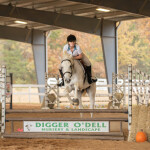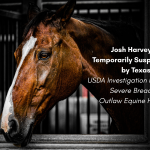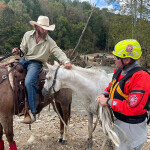Navicular syndrome in horses is a progressive condition with no cure. Learn about causes, symptoms, diagnosis, and effective management strategies to maintain your horse's comfort and quality of life.
A suddenly lame horse can strike fear into any owner, and while minor injuries are often hoped for, the cause may be something more serious—like navicular syndrome. Also called navicular disease or caudal heel pain, this chronic degenerative condition affects the navicular bone, deep digital flexor tendon (DDFT), and navicular bursa, leading to forelimb lameness, pain, and inflammation. Early detection through MRI is essential, allowing effective management with corrective shoeing, anti-inflammatory treatments, and tailored hoof care to keep horses comfortable and performing at their best.
What is Navicular Syndrome?
Navicular syndrome is a chronic, progressive, and painful condition that primarily affects the navicular bone, a small, flat bone located at the back of the coffin joint near the heel. Surrounding the navicular bone are key structures essential for movement, including:
- Navicular bursa
- Coffin (pedal) bone
- Impar ligament
- Suspensory ligament
- Deep digital flexor tendon (DDFT)
- Digital cushion
- Frog
- Heel bulbs
These structures function like a pulley system. The navicular bone connects to the coffin bone and pastern joint via ligaments, while the deep digital flexor tendon (DDFT) runs underneath. Together, they play a crucial role in the horse's movement.
Signs and Symptoms
One of the earliest signs of navicular syndrome is low-grade, chronic lameness. Initially, the horse may seem slightly “off,” but the lameness worsens as the condition progresses. Common symptoms of navicular syndrome include:
- Short, choppy strides
- Pointing the toe while at rest
- Difficulty turning or moving downhill
- Frequent stumbling
- Stiffness in the neck and poll
- Noticeable gait changes when circling, especially at a trot
- Increased difficulty standing for the farrier
Navicular syndrome is often confused with laminitis, but the two conditions show distinctly different symptoms. Horses with laminitis tend to shift weight off their toes (the front part of the hoof), whereas horses with navicular put more weight on their toes to avoid pressure on their heels. Additionally, laminitis often presents with "hot hooves" and an increased digital pulse—symptoms not associated with navicular syndrome.
Understanding these key differences can help in early identification and treatment.
Diagnostics
If you suspect your horse may have navicular syndrome, it's important to consult your veterinarian. The vet will begin by observing the horse's movement on both hard and soft surfaces, performing flexion tests, and using hoof testers to identify pain or sensitivity. A nerve block on the palmar digital nerves may also be conducted, as these nerves provide sensation to the navicular bone and surrounding structures. If the horse shows improved soundness after the nerve block, it strongly suggests navicular syndrome. For a more accurate diagnosis, advanced tools like X-rays, ultrasounds, or MRIs may be used to confirm the condition.
Management
Navicular syndrome cannot be cured, but it can be managed to alleviate pain and keep your horse comfortable. Here are key steps for effective management:
Medications
Non-steroidal anti-inflammatory drugs (NSAIDs) can reduce pain and inflammation, and injecting corticosteroids directly into the navicular bursa can provide additional relief. Work closely with your veterinarian to develop a medication schedule, including proper dosages, to ensure your horse's comfort and safety.
Corrective Shoeing
Collaborate with your farrier to create a therapeutic shoeing plan tailored to your horse's needs. X-rays will help determine the best approach. Common recommendations include rolled-toe egg bar shoes or wedge shoes, which are designed to reduce pressure on the navicular bone and surrounding structures. Proper shoeing is crucial to maintaining hoof balance—without it, pain and inflammation will persist.
By combining these strategies, you can help your horse stay comfortable and maintain quality of life despite navicular syndrome.
Turnout and Feeding
Navicular syndrome is not directly linked to feeding practices, but maintaining a healthy weight in your horse is essential. Excess weight places additional strain on the musculoskeletal system and increases pressure on the navicular bone. Horses with navicular syndrome should be fed a diet that supports hoof and bone health. Ensure their feed includes adequate amino acids, trace minerals, and biotin to promote strong hoof structure. Adding supplements to their diet may be beneficial—consult your veterinarian or equine nutritionist for guidance.
Maximize turnout time for your horse, as movement improves blood flow to the hooves. If your veterinarian and farrier approve, consider reintroducing the horse to light work, which can also support circulation and overall health.
Long-Term Outcomes
While there is no cure for navicular syndrome, the long-term outlook varies depending on the individual horse, the severity of the condition, and the quality of farrier care. Many horses with navicular syndrome can remain sound enough for certain activities, such as flat riding, though more strenuous tasks like jumping may not be suitable. Develop a long-term management plan to adjust your horse’s workload as their condition changes over time.
Conclusions
Navicular syndrome is a progressive and serious condition with no cure. However, with proper management, owners can help their horses remain as comfortable and functional as possible. Work closely with your veterinarian and farrier to create a tailored plan that includes weight management, proper nutrition, turnout, and appropriate levels of activity. Taking proactive steps will help you support your horse’s quality of life for years to come.
For more insights like this one subscribe to our premium digital monthly subscription here!









